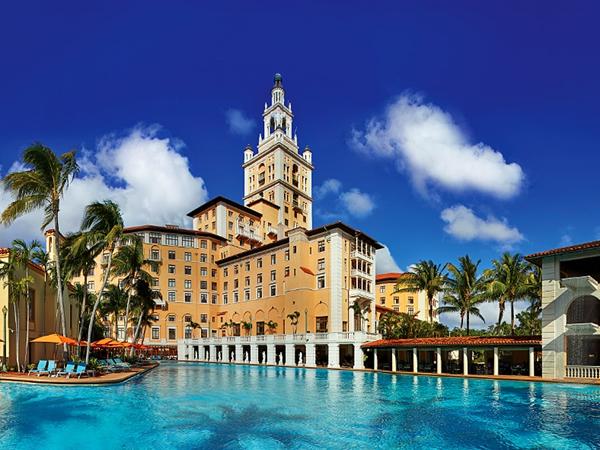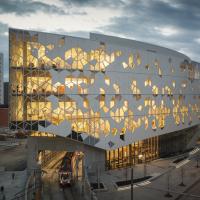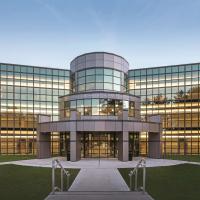
Date: 25 November 2019
A “Who’s Who” of heroes and villains, from Franklin Roosevelt and Babe Ruth to Al Capone, have strolled through its elegant lobby over the years; yet, when the time came to maintain the historic integrity of a classic Miami hotel, a chance meeting between its project manager and an expert from Vitro Architectural Glass may have been one of the most important in its storied past.
Old-world charm and the notoriety of its guests have come to define the Biltmore, the iconic Mediterranean-themed hotel located in Miami’s exclusive Coral Gables neighborhood. Built in 1926 and designated a National Historic Landmark 70 years later by the National Register of Historic Places—an elite title offered to only 3 percent of all historic structures—the Biltmore needed a makeover to help it remain a major player in the area’s fiercely competitive hotel market.
Although the sprawling resort underwent a full restoration in 1986, a fresh new feel was needed. Hotel executives wanted to usher in a more modern era, but without sacrificing the rich architectural detail that had made the hotel a venerated presence in Miami’s tourism industry.
A series of major changes started in 2017, when the lobby was renovated—beige monotone and period furniture was replaced with custom-built pieces in green and blue velvet resting on an indigo wool carpet.
The $25 million, five-year upgrade also included the replacement of 800 guest room windows. Due to a mandate from city officials in Coral Gables and the hotel’s status as an historic landmark, two specific criteria had to be addressed before the project could begin.
First, certain aesthetic and character-based requirements had to be achieved, including preservation of the original wood window design; and second, the new glass units had to comply with contemporary energy and impact codes.
Wanted: A Glass Manufacturer
Vladan Gluvacevic, project manager, The Biltmore, had done his homework—performing plenty of engineering calculations—and knew a low-emissivity (low-e) coating was necessary to comply with energy standards, and that a laminate was needed to meet impact-rated requirements. He just wasn’t sure which manufacturer could best meet his needs.
Although he had not previously worked with Vitro Architectural Glass, Gluvacevic was familiar with the company’s broad array of energy-efficient products. The next step was to determine which one could provide the necessary quality, performance characteristics, aesthetics and functionality for replacement windows at the Biltmore.
The Fenestration Manufacturers Association’s (FMA) annual conference provided the perfect forum for the expert guidance Gluvacevic sought. Once he learned that Vitro representatives would be attending, Gluvacevic registered for the event specifically “to discuss the project with someone from Vitro.”
That someone was Paul Bush, director of quality and technical services, Vitro Architectural Glass. “Vladan didn’t know who I was, and I didn’t know who he was,” Bush explained. “During a break, I introduced myself and he proclaimed, ‘You are the guy I came here to see.”
Subsequent discussions focused on Gluvacevic’s engineering data, the window requirements, testing protocols, potential fabricators and how Vitro could help. After analyzing a range of possible glass configurations, Solarban® 60 glass was chosen for two primary reasons: It met the neutral aesthetic requirements of the original glazing, and the product’s improved solar heat gain coefficient (SHGC) and excellent U-value provided the energy performance required for the new impact-rated window design.
Nathan McKenna, architectural manager, Vitro Architectural Glass, met with Gluvacevic and facilitated a meeting with OldCastle BuildingEnvelope (OBE), a Vitro Certified™ fabricator, which produced the insulating glass units (IGUs) for the project. “This project wasn’t a huge bulk order,” McKenna explained. “With the five-year timetable, incremental orders were placed for smaller quantities. Because of the proximity to the hotel and their ability to both laminate and insulate the glass, OBE provided the quality and service level Vladan needed.”
On-Site “Factory”

Maintaining a historic look while providing necessary updates to a beloved building can be among the bigger challenges during a renovation. It also can be personal.
For Gluvacevic, striking that delicate balance for the windows didn’t end with selecting the Solarban® 60 glass. Designing the window to exacting standards to meet historic and aesthetic requirements—all while controlling costs, meeting precise quality criteria, testing and staying on schedule—meant entrusting the job to a source he knew better than anyone: himself.
Gluvacevic established a large custom manufacturing shop with all the necessary machinery in the hotel’s basement, hired experienced, high-end craftsmen to handconstruct and assemble the window components and test each finished window assembly.
A customized wood mullion joint that incorporates a ½-inch-by-4-inch steel beam provides structural integrity and reinforced loadbearing capabilities. Steel plates were used to transfer loads from the steel beam to the outer jamb and then attached to the wall. This unique construction enabled the windows to pass hurricane (load), water infiltration and pressure tests.
Old Can Be New Again
As the renovation of the Biltmore winds down, it’s clear that guests who both demand modern amenities and pine for nostalgia will be able to enjoy those conveniences while stepping back in time.
Vibrant colors, updated furniture, LED lighting, and increased wireless connectivity are framed by historic windows approved by the National Trust for Historic Preservation. The look of the windows perfectly matched the original, and the impact-rated IGUs with Solarban® 60 glass met the 0.39 SHGC threshold required for the project to meet energy performance and impact code standards.
By the time all 800 windows are installed, it’s estimated that Solarban® 60 glass will save the hotel approximately 100 lbs. of cooling capacity, reducing energy consumption by 14 percent.
The meeting between Gluvacevic and Bush at the FMA conference paid off in more ways than one. Vitro Glass provided expert product knowledge, guided the glass-selection process and helped locate the right fabricator for the project. With this expertise, Gluvacevic created an updated glass design that not only met the requirements of the original glazing but also complied with stringent energy and impact guidelines.
“Working with Vitro Glass has been great. They helped me establish direct relations with our laminator (OBE),” said Gluvacevic. “The whole process, from getting the glass that met all the requirements to the proper documentation was much easier than if I’d tried to do it on my own,”.
 600450
600450
















Add new comment